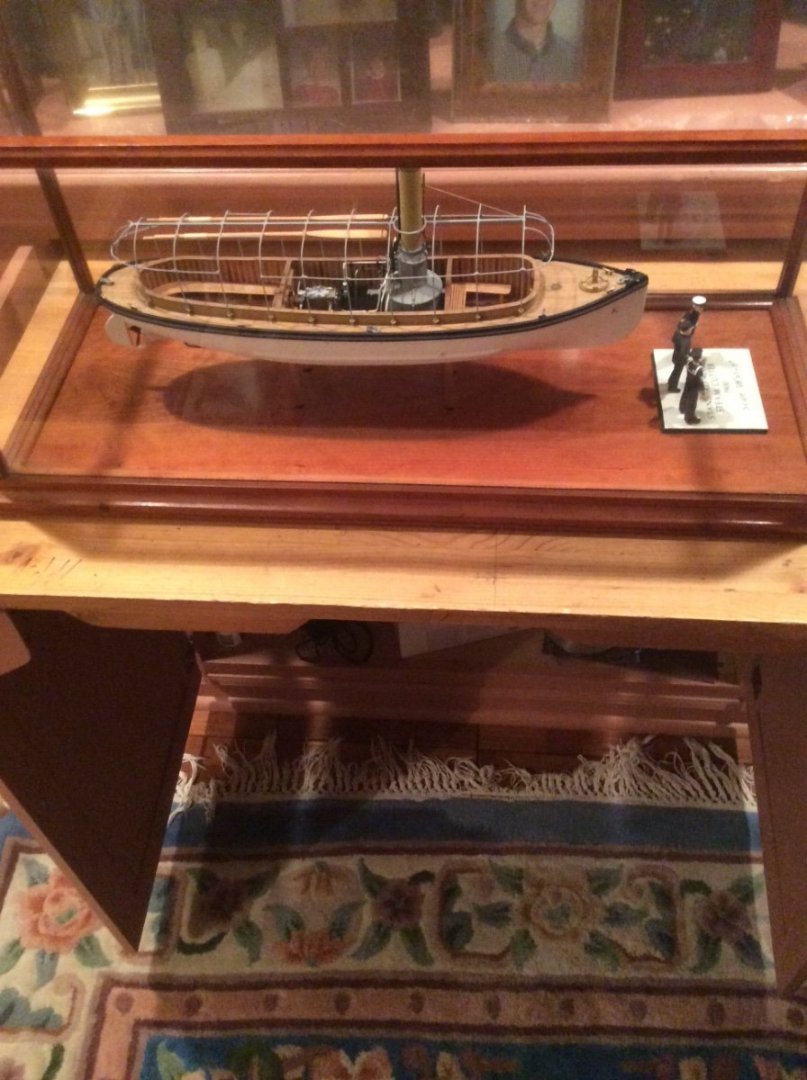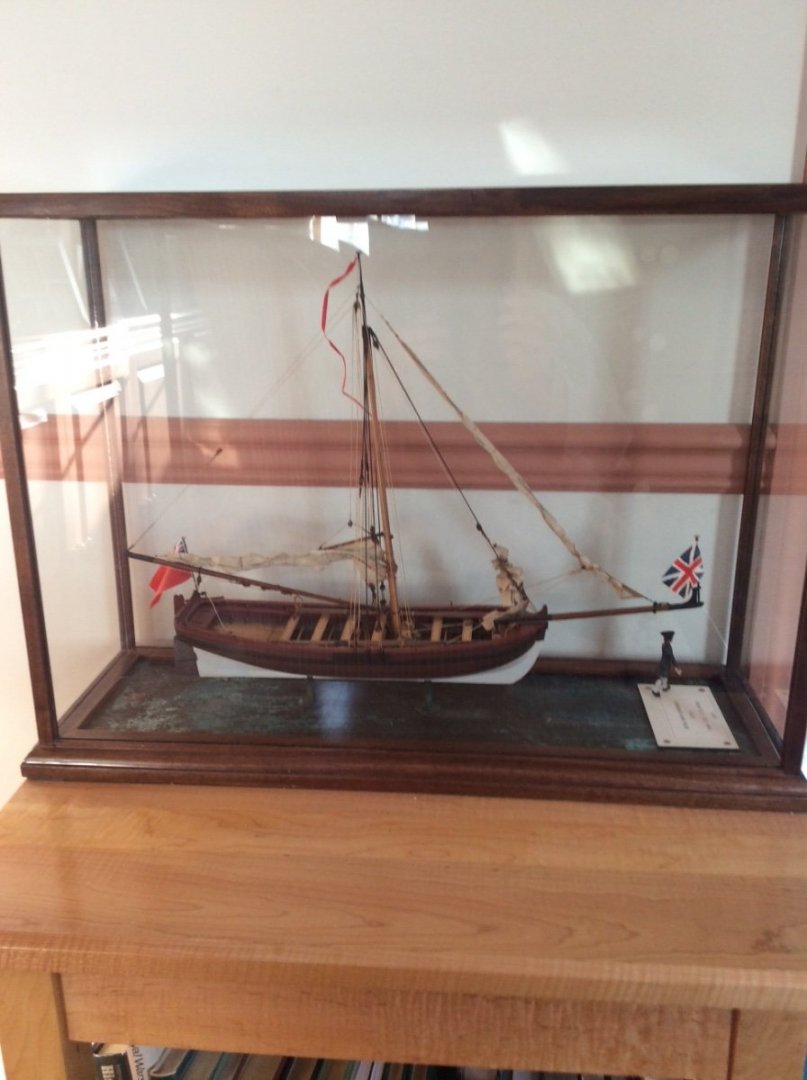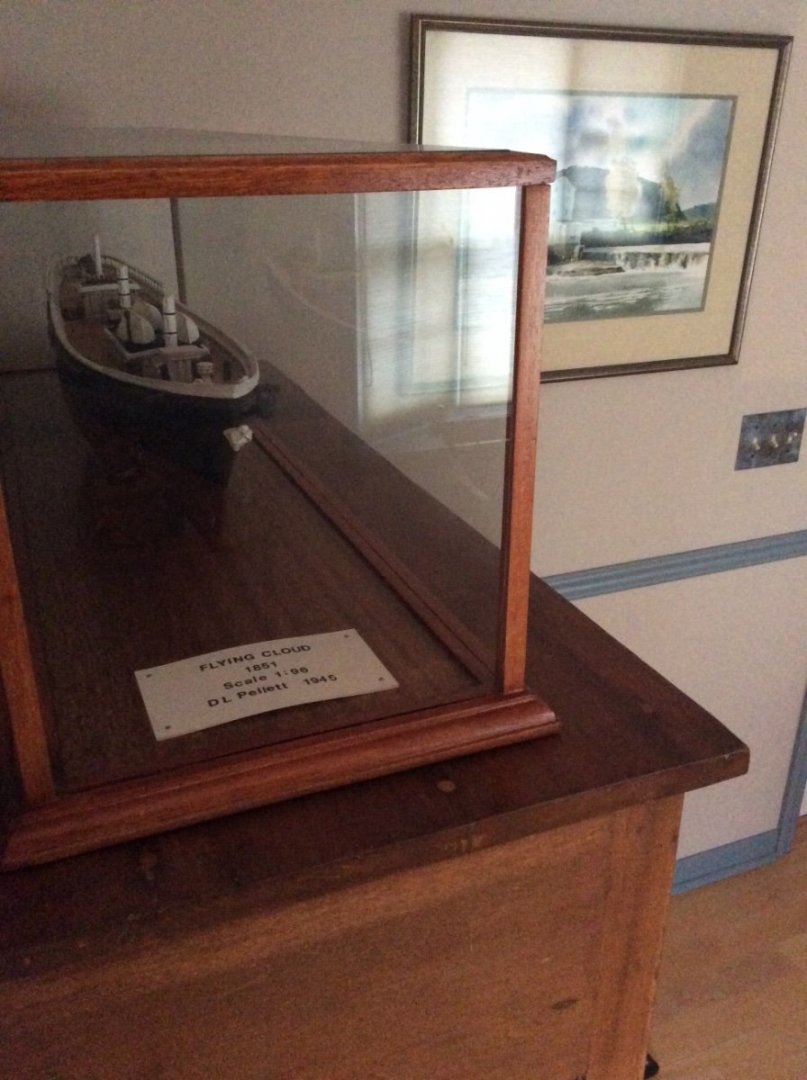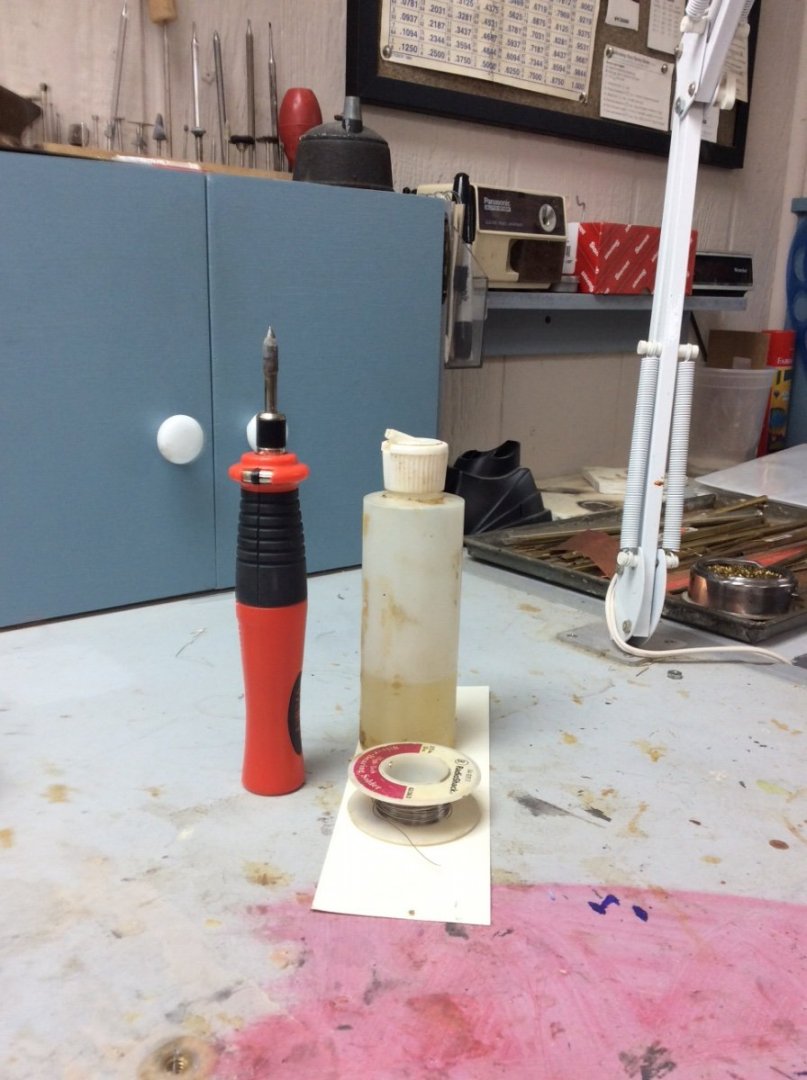
Roger Pellett
NRG Member-
Posts
4,519 -
Joined
-
Last visited
Content Type
Profiles
Forums
Gallery
Events
Everything posted by Roger Pellett
-
I have used Fiebing’s leather dye too. It’s good stuff. Shoemakers stock it. Unfortunately they are rapidly becoming extinct. Roger
-
Generally speaking what looks most like the real thing is paint. With the exception of the deck, ships were protected from the weather with some kind of coating- white stuff, black stuff, copper sheathing, or anti fouling bottom paint below the waterline. Topsides were tarred and in later years painted. Decks were sanded regularly with holy stones or left to weather. Unless done by one of the masters using the woods posted by Allan above, much of the natural wood school of modeling IMHO looks amateurish. The “walnut” offered in kits is a marketing ploy to convince buyers that they are getting something deluxe. Roger
-
The actual crew size during the voyage is not the point. It is the size of the crew that she was originally built to accommodate. As I said in my original post, a huge number of steamships in the early 1900’s were built in British shipyards to Board of Trade manning standards. As the vessel’s aged, they were sold, often several times and reflagged.
-
Artillery batteries with both armies were equipped with horse drawn forges that moved along with the troops. The “guts” from these forges could easily been used aboard ship.
-
Several Points: Von Bednar is building a ship from the King Kong movie. King Kong lived on some far away exotic island, not coastal British Isles. Visiting his island required a deep sea voyage. British flagged vessels were governed by British Board of Trade regulations. These would have required a licensed watch keeping officer on the bridge and in the engine room for each watch. The captain usually did not stand watches. Watches were stood on either a two or three watch system. In the early 1900’s almost all steam powered merchant vessels were coal fired. This would have required at least one and more probably two fireman per watch. Depending on the layout of the bunkers, some ships carried a coal passer for each watch to keep the firemen supplied. All machinery in the engine room; the engine, plus the pumps and generating sets was open frame and reciprocating. This meant that many bearings were hand lubricated. This required an oiler continuously making the rounds in the engine room to keep moving joints lubricated. I am currently building a model of a small steamship (240 ft) built in 1908 that sailed on the Great Lakes. When lost in 1914 she had a crew of 20. Roger
-
In the early 1900’s the British Merchant Marine dominated the ocean shipping business and the vessels that they sailed were built in British shipyards. In these small vessels accommodations were primitive. The crew lived in the forecastle. There would be a door from the main deck to the forecastle and probably an overhead hatch and ladder. The forecastle was heated with a coal stove that was also used for cooking. Bathrooms- an outhouse sort of structure dumping directly overboard and a bucket for washing up. Sometimes the forecastle was split, the deck seamen living in one half and the “black gang,” the engine room gang, living in the other. The watchkeeping officers- The Captain, two or three mates, a chief engineer, and two or three assistant engineers plus the officer’s cook lived in the deckhouse. This is all described in the book “Old Time Steam Coasting” by Spargo and Thompson, another in the C. V. Waine series of books. Roger
-
I would think that a forge would also require a stack, both to provide draft and to exhaust fumes, smoke, and sparks.
-
An interesting example of supply and demand as the plate has no intrinsic value. It’s only valuable as a collectible. There must have been 100’s if not 1000’s of Baldwin steam locomotives built, but there is huge interest in railroad collecting; as part of the model railroading hobby and as a stand alone activity. On the other hand, there was only one USS Tennessee and to serious students of US Navy history she and her sisters were historically significant. She was one of the attempts to build very high speed “commerce destroying cruisers” at the end of the Civil War. She reflects the efforts of marine engineers to build high powered steam plants prior to invention of triple expansion engines and later, steam turbines. She has associations with two important Nineteenth Century marine engineers; John Ericsson and Benjamin Isherwood. There is little interest in the US Navy in the period between the end of the Civil War and the emergence of the Great White Fleet. It would be interesting to know if the Baldwin Locomotive nameplate commands an $8000+ price vs the Tennessee nameplate a $2000+ price. If I were you, I would monitor the EBay site. You might be able to buy this later at a heavily discounted price. Roger
-
Here in the US, sources of brass and German Silver sheet stock, particularly in heavier thicknesses are the suppliers of materials for building muzzle loading rifles. Three companies are: Dixie Gun Works, Union City, TN; Track of the Wolf, Twin Cities Area, MN; and The Log Cabin Shop, Lodi, Ohio. Roger
-
The last step in building a model is to build a wood framed glass case to protect it. My system for building these produces a neat case but not one that would win a cabinetry contest. I have models that have resided in cases that I have built for over 30 years that are dust free. My house has gas force air heat and we have a very long heating season. My preferred wood for building these cases is Native American Black Walnut but I have also used Cherry, Mahogany, and Teak. I use a table saw to rip wood, cut grooves for glass, cut mitered joints, and with a set of moulding heads to shape base mould inns. Here are. Some pictures:
-
Stainless steel is difficult to work with; it is “tough” so hard to cut and form and I don’t believe that it can be readily soldered. It shrinks if welded. I see no reason to use any of the steels; carbon or alloy, when there is an excellent alternative- Brass. Brass is readily available as sheet, wire, rod, and round, square, and rectangular tube. The square and rectangular tube can be ripped and fabricated to make various structural shapes. Brass is easily soldered using ordinary soft soldering materials. It also machines well. It has ample strength for our purposes. Roger
-
Off and running with the schooner rigged pond yacht
Roger Pellett replied to Elmina's topic in Masting, rigging and sails
They must be the other 1%. Their belaying pins look much better than most. -
Off and running with the schooner rigged pond yacht
Roger Pellett replied to Elmina's topic in Masting, rigging and sails
Mike, Just a heads up. 99% of belaying pins supplied by kit manufacturers are awful and I don’t know who makes the other 1%. They are usually way over scale and shaped more like bowling pins than belaying pins. if you can find accurately shaped belaying pins large enough for this model or if you have the ability to turn your own, great. Otherwise, some brass rod, cut to length with the top end rounded off may be the best choice. Roger -
Off and running with the schooner rigged pond yacht
Roger Pellett replied to Elmina's topic in Masting, rigging and sails
Those are called Fife Rails. They have nothing to do with “Fire,” the incendiary kind or otherwise. They are simply there for belaying running rigging lines leading downward from the masts. On a real ship there would have been holes where the wires are sticking up. Removable belaying pins would have been fitted into the holes. In your case, the model maker substituted pieces of wire for the specially shaped belaying pins. The belaying pin was an ingenious but simple invention. It allowed the middle of a line to be secured with a secure but easily released hitch. Roger -
Looking good! When you consider that the real thing was just one of hundreds (thousands ?) of unexceptional merchant ships, the work required to have built it is astonishing. Your model well illustrates this point. Roger
- 201 replies
-
- SD 14
- Marcle Models
-
(and 1 more)
Tagged with:
-
When cordless soldering irons first came on the market I thought “that’s the height of stupidity, how could one produce enough heat to work?” When I resumed work on my Benjamin Noble Lake Freighter Model after a several year hiatus, I decided to “tool up” with new soldering equipment as virtually everything above the basic hull is soldered brass. Materials include brass wire, tubing, structural shapes, machined parts, and sheet. I bought a conventional 40 watt chisel point soldering iron, a new propane torch, and even rigged up a homemade resistance soldering unit. I also decided to buy a cordless soldering iron figuring that it might be useful for soldering tiny parts. It is a Weller unit that heats to 950F. See photo below. Long story short, so far it is virtually the only piece of equipment that I have used. For work that we do, I have come to believe that the iron’s tip temperature is often more important than the wattage rating. An iron that heats a small spot quickly avoids melting adjacent soldered joints. I also recommend a bottle of Bakers Fluid liquid flux and some very fine solder. The wire that I have been using has a diameter of only .020in, about .25mm.
-
Re: Chuck’s post above. “Cuttyhunk Hard Twisted” linen fishing line is nice stuff. Unfortunately it is no longer made. I bought a supply from the old (yellow box era) Model Shipways years ago. Look for it on EBay.
-
The reduced displacement idea has been studied for full sized ships as a means of reducing the spread of invasive species from ballast water. With free exchange of water from the outside to inside the tanks, contaminated ballast water is not hauled from one port to be discharged at another. Roger
- 454 replies
-
- Union Steamship Company
- Stepcraft 840
-
(and 3 more)
Tagged with:
About us
Modelshipworld - Advancing Ship Modeling through Research
SSL Secured
Your security is important for us so this Website is SSL-Secured
NRG Mailing Address
Nautical Research Guild
237 South Lincoln Street
Westmont IL, 60559-1917
Model Ship World ® and the MSW logo are Registered Trademarks, and belong to the Nautical Research Guild (United States Patent and Trademark Office: No. 6,929,264 & No. 6,929,274, registered Dec. 20, 2022)
Helpful Links
About the NRG
If you enjoy building ship models that are historically accurate as well as beautiful, then The Nautical Research Guild (NRG) is just right for you.
The Guild is a non-profit educational organization whose mission is to “Advance Ship Modeling Through Research”. We provide support to our members in their efforts to raise the quality of their model ships.
The Nautical Research Guild has published our world-renowned quarterly magazine, The Nautical Research Journal, since 1955. The pages of the Journal are full of articles by accomplished ship modelers who show you how they create those exquisite details on their models, and by maritime historians who show you the correct details to build. The Journal is available in both print and digital editions. Go to the NRG web site (www.thenrg.org) to download a complimentary digital copy of the Journal. The NRG also publishes plan sets, books and compilations of back issues of the Journal and the former Ships in Scale and Model Ship Builder magazines.







